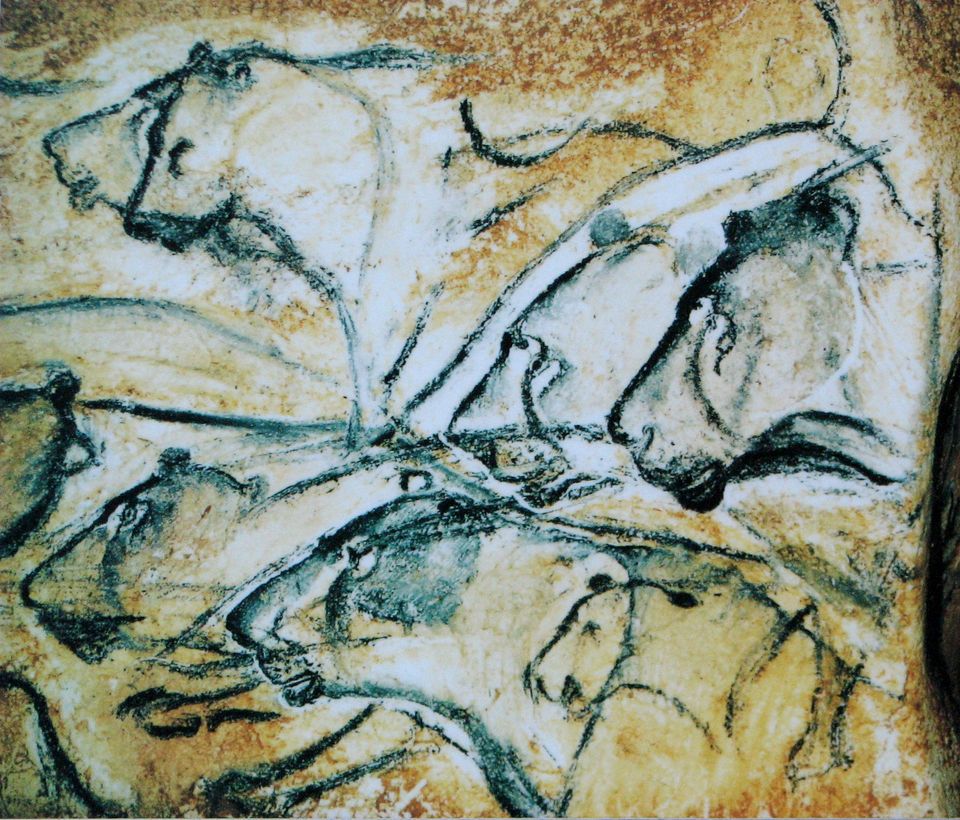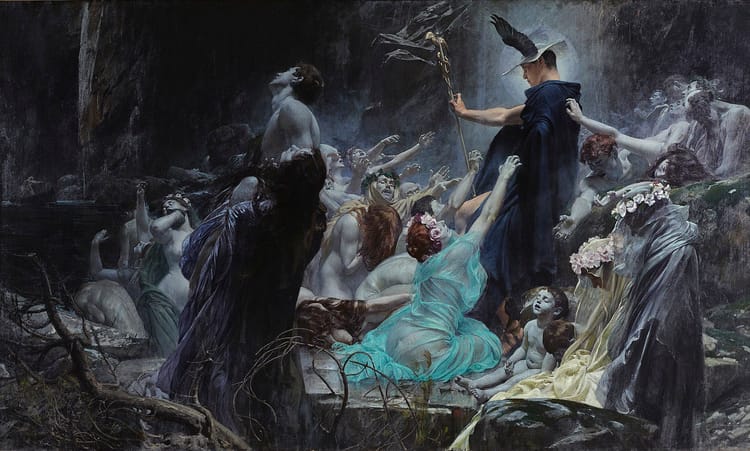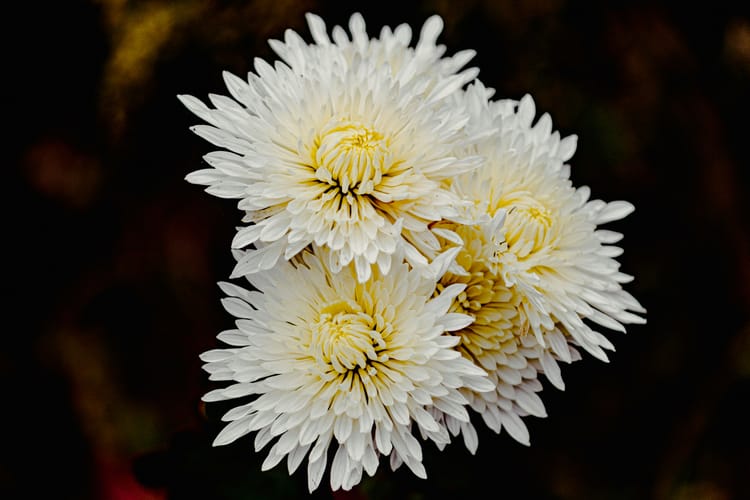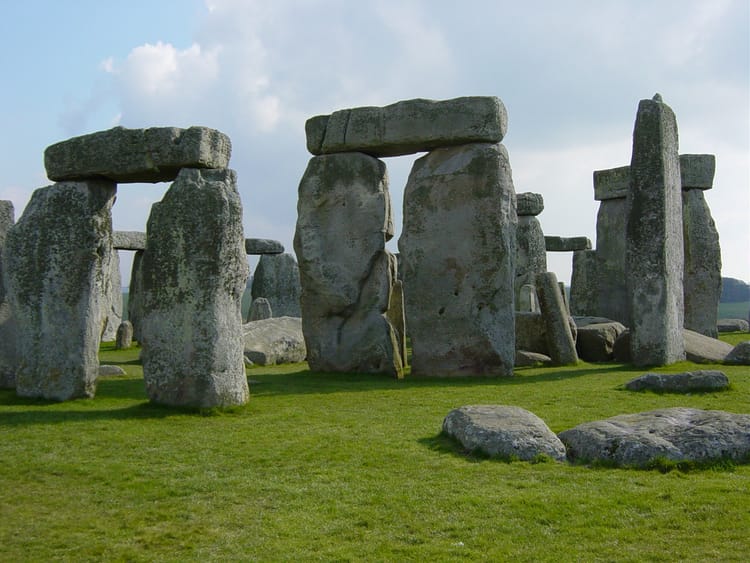Full Moon: Primordial arts & beyond

It's Friday, and a very hot Friday where I am. But I'm surviving, and I hope you are, too. Hello.
This post concerns the matter of art's ancient ritual significance, leading to some preliminary implications for something I'm going to write about later, the question how old is kink? My thoughts here are still in an organizational process, and more than usual I need to engrave a reminder that I'm not writing from a trained academic perspective. In this case I'm writing from the perspective of a hands-on ritualist and hands-on artist, pulling together ideas that stem either from my bachelor's-level education, from books I've read since then, or just from my own head. I have more familiarity with anthropology than some people do, but I'm nowhere near as up to date on the latest research or theories as someone who's devoted their life to such things.
So although I'm actually going to mention some of "the latest" here, this is coincidental; I strongly advise that if you desire a certain flavor of scholarly rigor then you should read something that isn't today's post.
But... (a very significant "but")
But I've mentioned anthropology — now, in many leftist spheres that I've walked through, anthropology is increasingly passé. The field's members have committed or fueled so many colonialist transgressions that I wouldn't even know where to start with enumerating them; likewise, as a book I'm soon going to reference points out, contemporary anthropologists have ceded a lot of theoretical ground to evolutionary psychologists, whose own studies are increasingly a quagmire[1] that the left also reasonably frowns on. So I don't wish to wade into anthropological topics with some naïve belief that no harm has been enacted through such discursive space, or that everyone today regards anthropology as extremely respectable. Indeed, I should even emphasize how whatever the field, having a special piece of paper does not prove you have any more inherent right to offer your opinion about something than, say, a person with directly lived experience of the subject in question. Charlatans can earn PhDs while some of the biggest experts in many topics never even go to school at all.
However: by and large, spending at least half your waking hours dealing academically or directly with something is a much more likely guarantee that you know more of what you're talking about than someone (in this case me) who pays attention to the subject but is usually only thinking or learning about it a few hours per month. And in the case of prehistories and proto-histories where all oral tradition from that particular time and place has been severed or irrevocably obscured — such as Upper Paleolithic humans who painted a cave in present-day France — I think there's also no lived experience to fall back on, only research. In that vein, I've always been fascinated by anthropology of the far distant past: the study of what human cultures constituted in a time preceding writing systems, sometimes preceding agriculture, sometimes even preceding Homo sapiens as the single dominant hominid species on Earth. This is the very ground that evolutionary psychology is rolling around in like mud, constantly advancing untestable ideas about how every human behavior or societal development has come about as a necessary outcome of fated evolutionary pathways, ignoring that evolution is just a series of accidentally successful random mutations.
All of this is prelude to saying that for the past couple weeks I've been reading a book that I absolutely love: The Dawn of Everything by David Graeber and David Wengrow. Published last year, posthumously in Graeber's case[2], so far I've found the work to be a stunningly well-argued upset of anything Westerners are taught in school about many aspects of human cultural history, from the adoption of farming to the adoption of democratic governance (or for that matter the adoption of monarchies). As a takedown of grand, capital-T theories, the book does in a way present its own capital-T theory, which should always signal for the audience to read carefully and skeptically; however this isn't The Da Vinci Code or The Witch-Cult in Western Europe. So far I'm more than halfway through, and I don't necessarily agree with every conclusion that Graeber and Wengrow draw, or every possibility they float, but I'm now firmly convinced of their central idea that humans didn't just start their earliest societies through "unenlightened," crude, basic arrangements that then grew more complex over time. Rather, as soon as humans' brains evolved, they were as they are now, and so we've always been extremely socially sophisticated even without writing or agriculture.
This is something extremely important to consider as part of one's personal decolonial process — to consider that the real problem with applying "noble savage" archetypes to indigenous peoples is not in thinking that their very old wisdom has value, but in thinking of it as a simplistic, childlike wisdom that doesn't build "great" societies, or that despite its worth is doomed to be swept away by the march of "progress." If you ever need more proof that Europeans destroyed countless highly-developed civilizations through disease and sheer bloody-mindedness, please read this book. And on a personal level, reading The Dawn of Everything dovetails neatly with something I already meant to write about for this Full Moon, which is how our most primordial art doesn't strike me as "primitive" at all but rather as a deeply considered and self-aware structuring of communal relations. I will come back to Graeber and Wengrow's book when I'm finished with it and have more time to sort out my exact position on everything there, but in the meantime: to art. Ancient, primordial art, and beyond.
On representation
In the annals of art history, my impression is that humans have been sculpting things about as long as we've been painting. So we've probably been thinking of art as a three-dimensional prospect for about as long as we've thought of it two-dimensionally. Also, while I believe most petroglyphs — that is, rock carvings, not paintings — are a somewhat later invention, they're still preposterously old. And there's even controversial but promising evidence that Neanderthals could have had their own art despite traditional notions that only members of our current species have ever been artists. All of this is to say: though I deliberately chose to open this post with a particular cave painting, and though cave paintings are probably my favorite early art, it's important to remember that cave paintings don't seem to represent one distinct stage of artistic evolution. There's no tidy linear progression from non-artist Neanderthals to cave-painting humans to rock-carving humans to sculpture-making humans.
But whatever exactly happened in art history between 10,000 and 40,000+ years ago, one thing that's long interested me is how despite the simplicity of tools and materials used for creating primordial art, there's no corresponding simplicity of ideas held within that art. Universal resonance, perhaps, but that's different. If I look at a cave painting or ancient sculpted beads, if I really look instead of staring with the gaze of a faux-advanced modern era, there's as much for me to appreciate in the line art or the chisel strokes as there is in a Caravaggio painting or a Hokusai print.
This matters because in the popular imagination and even in some sectors of art history, primordial artworks are framed as the product of unconsidered, hacky attempts to make something, and this thinking goes hand-in-hand with the exoticization of colonially pillaged "tribal art," of "folk art," or of "brutish" outsider art. I think it's possible to evaluate and debate art by how well it succeeds at what it's setting out to be, and it's also possible to cultivate a personal taste for what art you like or don't like, and it's even possible to rate commercially produced art against art produced without financial incentives; but I think it's not possible, and in fact very wrong, to place art on a strict continuum of crudeness to sophistication. When someone gets down to the business of making an artwork, it doesn't matter what time period or culture they belong to; if they're a human then they're approaching their project with a human mind, a human capacity for expression.
It would even feel misleading for me to say that someone with the genius of Caravaggio had to exist among the people who painted Chauvet Cave. Maybe it would be more accurate to say that as much of a great painter as Caravaggio was, if you sent one of the Chauvet Cave painters into Caravaggio's own time and handed them all the oil paints and brushes and things at Caravaggio's disposal, once that person had enough time to learn how to use them they would be no less likely to produce Caravaggio-like art than you could say of Caravaggio at the start of his own art career. The "gap" between primordial art and more modern art is forged by technology, not intellect, and it just doesn't even really seem like a gap to me at all.[3]
This isn't just a conclusion I've reached for political reasons; it's personal to me as an artist. The longer I've been alive, creating art that's important to me even if it has a very limited audience — depending on your litmus test, I am an outsider artist, and otherwise I still have very little formal training, mostly constant practice — the more I chafe at anyone suggesting there's some kind of enshrined true, complete art that satisfies special requirements of sophistication, and that should be contrasted with deficient, thoughtless, and therefore less meaningful or valuable art.
All art contains whatever meaning or value that the creator or audience (or both) put into it. And what moves me about the very oldest art is how the meaning is, to me at least, quite obviously on the level of the sacred. This isn't the kind of sacredness that comes with stereotyped, obedient, once again "unthinking" worship; it's a conscious recognition of a communal, animist cosmos, and our place in it.
For though singular humans are sometimes represented in primordial art, often we appear in groups, especially as clusters of handprints on a wall. It isn't one person outlining their hand and saying, "I am here," but a suggestion of multiple people saying, "We are here." And in reading about primordial art I've actually learned that non-human animal representations vastly outnumber humans.
Sometimes these are animals we might have hunted, and sometimes they are animals to whom we might have held some other relation, but a relation is key. I gather that scholars love to debate whether the animals are fashioned as representations of actual animals someone witnessed, or as ideal forms of an animal that mattered to the artist; and likewise we can ask whether these animals were totemic, bringing guidance and kinship bonds. But whatever the answer, I'm most interested in how our ancestors chose to focus on animal representation for any reason. Maybe this art was made after some people started to already think of themselves as being different from animals, maybe not — yet our earliest representative attention is given to other species, not to extensive documentation of what we ourselves were doing.
I think this is beautiful. The earliest art isn't devoid of the human self, but it's hardly wrapped up in it either. It's a recognition of all life. And with cave paintings or petroglyphs in particular, I love considering the possibility that they were dynamic artworks. Multiple creatures and scenes would be added next to each other over the years, maybe even over generations. Even the images themselves have movement, both in the running or leaping forms of the depicted animals, and potentially in an outright simulation: take another look at the lionesses of Chauvet Cave above. It's been speculated that the overlapping silhouettes in certain areas might appear like this so the shadows cast by flickering firelight could selectively illuminate the lioness heads in certain positions, thus suggesting motion on a literally cinematic level.[4]
From representation to performance
I now look later in history, not as far as modern filmmaking but only as long ago as early theatre. I've never seen anything about the history of theatre that suggests theatre is more than a few thousand years old; theatre as we think of it today can also be traced back concretely to a few specific cultures. However, I think one of the great anthropological questions about theatre is not the when or where of its origin, but the why.
It's tempting for me as a ritualist and erstwhile "theatre person" to see theatre derived from ritual in a very direct fashion. It would make a perfect kind of sense; after it became commonplace for humans to hold rituals to honor spirits and deities, using costumes or props, performing special dances and following a rehearsed script, even embodying the divine through possession, then surely it's not a far leap to imagine extending these practices to general dramatization of events involving those figures, and then extending things to more mundane characters.
Seemingly, however, anthropologists and theatre historians don't all agree on this point. Aristotle is cited for what he observed about Greek theatre differing from the practices of actual mystery cults, which persisted simultaneously, including for Dionysos who I keep circling back to in this newsletter; Aristotle said that the rituals of a mystery cult required audience participation, whereas for theatre the audience was passive. I don't know whether similar comparisons have been made for classical Chinese or Indian theatre, for example, but either way there's a good point here. Is it possible that theatre simply developed as an offshoot of the representational instinct in earlier art? Perhaps members of some cultures just decided over time that it wasn't enough to create simulacra of the world around us, but to combine this with oral storytelling traditions into embodied performance: "to hold as 'twere the mirror up to nature."
If that were the case, I might even wonder about communal ritual deriving from theatre, not the other way around, as people gradually sacralized the stories they were performing. Does that sound strange? Think of how fandoms can become their own cults, or just go to a shadowcast of The Rocky Horror Picture Show.
I honestly don't know which theatrical origin story I prefer, and I suppose it's a chicken and egg problem unless there's some evidence I've missed entirely. But I'd certainly allow that with certain exceptions, what qualifies as theatre in modern Western-colonial society is not identical to what qualifies as ritual. They aren't the same, no matter how they might correlate. By the same token, though, I would say that theatre can always be ritualized, whether that's a return to its roots or a potential energy it inherently carries.
Thus theatre carries a kernel of the sacred at all times. Even when a theatrical performance isn't a ritual, it can still be a reenactment of past struggle or a prefiguring of future possibilities; there is animist sanctity in those options, through affirming the actions of our ancestors and mythic figures, or through the deliberate creation of myths to guide the next generation.
As for that guidance: I used to think that theatre is one aspirational means by which humans can transmute our instincts toward real violence into cathartic fictions. But this presumes that theatre and other arts are "higher" than ourselves, divorced from our primordial evolution. If all art is sophisticated but also something we invented before many other parts of what we now consider normal human existence, then I don't want to see that high/low divorce anymore. There's nothing to aspire to in the transmutation that theatre offers; the transmutation already just happens. It has always been happening. We aren't moving on a clear track from exploitation and misery to communalism and goodwill; we have always been oscillating.
The two other activities I've long mentally paired with theatre for this imagined salvation project are sports — and kink. But as I reconsider theatre as a link to something that's been with humans for tens of thousands of years, in turn it strikes me that sports and kink may well have the same significance. Speaking especially as a kinkster, I'm now less convinced that kink is an attempt to transcend and liberate ourselves, and more that it's an outgrowth of something we've always been doing — and that we may even have always been doing consensually.
But that's a chapter for another time, when I will come back to The Dawn of Everything and start more fully teasing out the place of kink in ritual living. That might be a few weeks or a few months, so bear with me, and in the meantime I apologize again for the only partial cohesion in today's thoughts.
[1] That Wikipedia article itself desperately needs some help, but you can still get the idea.
[2] In 2020, David Graeber died of necrotic pancreatitis — an utterly horrific way to leave life, and potentially a complication of an asymptomatic covid infection, though we'll never know for sure. Having also read his earlier work Debt: The First 5000 Years, I believe that besides the general tragedy of his death we lost a magnificent mind far too soon. He was an extraordinarily hopeful, methodical, down to earth thinker whose debunking of conventional hegemonic myths should be considered vital reading for anyone on the left — whether (like him) you call yourself an anarchist, or not.
[3] What about matters like perspective drawing? Somebody could probably claim that the earliest human artists, even up to a certain point in modern art history, didn't use perspective in their art because they didn't understand it. I think that's a very strange assumption, though. People's eyes have always usually had depth perception, and I think that transmitting this perception into two-dimensional form is only important if you're trying to be "realistic," to copy what you see exactly. If your purpose as an artist is just to express something that you think is important, there's no requirement that you copy exactly what you see; realism in art is a trend, not a default goal. I'd easily bet you could teach a Chauvet Cave painter perspective drawing; they just didn't have an artistic reason to experiment with it on their own.
[4] It's been a while since I watched it, but I believe you can see this demonstrated in Werner Herzog's documentary about Chauvet, Cave of Forgotten Dreams.
If you did survive this one, thank you as always. Next week is something I've thought out a lot better: a meditation on the imperialist ironies of our hotter climate. And the week after that, I'm turning back to satanism, with a critique of consumerist, pop cultural presentations thereof. Until then, may the rain water you kindly and may the Sun shine just enough.





Member discussion